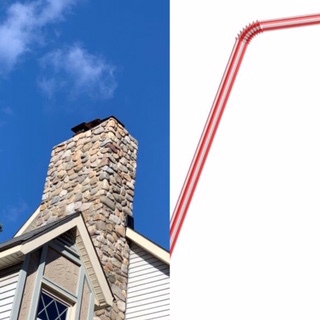When it comes to proper chimney functioning, one of the biggest things you need is good airflow. Draft and air pressure work together to ensure your fires burn strong and that all of the fumes, gases, and smoke created flow safely up and out of your flue. Yet, not many know much about how this process works actually, and find themselves frustrated when they can’t enjoy a cozy fire during the colder months.
By and large, all chimneys and venting systems work the same way. Whether we’re talking about water heaters, furnaces, boilers, fireplaces, or wood stoves, all of these units operate off of a neutral pressure plane within your home. Curious to know more? Keep reading because we’ve got the experience, facts, and know-how to always keep your chimney knowledge up to date!

All About the Neutral Pressure Plane
How does negative air pressure and the neutral pressure plane work exactly? Well, there is a point in your home where your air pressure starts to increase, causing it to rise and look for places to escape out of your home. If your home is too tight (well-insulated) and the air cannot escape, appliances below this plane won’t work correctly because the air flow won’t syphon in to create a draft.
Basically, when you heat something (like your fireplace), the heat wants to rise. Once it does, it has to pull in make up air to make a draft. But if your fireplace is built in a vacuum-tight, well-insulated home, it will not flow out, which means no make-up air can come in, and you’ll be left with smoke and other fumes entering your home. You need that make-up air coming in for things to flow efficiently.
Over-Insulating & Indoor Air Quality
Now, we know over-insulating your home seems like a good idea in theory, and we understand the appeal of keeping heat in during the cold months and cool air circulating in the summer, but this can actually lead to a lot of problems on top of fireplace inefficiency.
You see, the air in your home gets dirty and it needs to circle in fresh air. If new air can’t get in, you’ll just keep recycling that dirty air you’ve been breathing all day. In theory, if your home stays completely tight, you’ll eventually run out of clean oxygen to breath. Now, we don’t foresee this happening, as doors and windows don’t typically stay shut indefinitely, but maintaining good air quality will still be a challenge!
Now, this same thought process applies to your appliances. When new air can’t be circled in, they are left with nothing in terms of draft and airflow causing their overall efficiency to suffer. In the end, going overboard with home insulation isn’t going to be your best bet!
The Dangers of Smoke & Carbon Monoxide
As we’ve stated, trying to operate a fireplace without proper airflow can be immensely challenging. Yet, inconvenience and a loss of aesthetic appeal are only the first of your worries. Poor draft can actually lead to significant health risks, too!
In a wood-burning unit, for example, you’ll experience smoke entering your home, which can lead to respiratory issues, especially for those who already have asthma or severe allergies. That being said, the one good thing about smoke is that it is clearly visible in your home, so you know to get out of the area right away and open windows.
Not all fumes are as easy to detect, though. If you own a gas-fueled unit, it is vital that you are aware of the dangers of carbon monoxide exposure. Carbon monoxide is colorless, odorless, and tasteless, so noting its presence is next to impossible. Because of this it causes hundreds of deaths every single year.
What can you look for in terms of carbon monoxide exposure? Well, some physical symptoms include dizziness, nausea, vomiting, shortness of breath, confusion, fatigue, and other flu-like ailments. Keep in mind, though, that most assume these symptoms have to do with cold weather coming in and making people sick. This can lead to devastating health risks.
Don’t take any chances. Invest in smoke and carbon monoxide detectors for your home, and be sure you’re having your fireplace and gas-fueled appliances regularly inspected and serviced to avoid these deadly threats.
The Many Components of Your Fireplace
The components that make up your fireplace will vary based on whether you own a masonry system or a prefabricated unit.
Masonry set-ups consist of a brick or metal firebox where the logs go, a damper, a smoke chamber (which is essentially an upside down funnel designed to send smoke and heat out of your home), and a flue liner that runs to the top of the unit and pokes out of chimney crown.
A factory built fireplace will include a metal firebox (four panels with brick imprint), a damper mechanism, and an 8-10 inch round pipe that sends fumes away from your household.
Whichever type you have, investing in annual care is a must. Getting an inspection done before the start of your burning season ensures all damages are addressed, so that you can have proper airflow and safely enjoy your evening fires on the cooler fall and winter nights.
Think of this way – operating a chimney with gaps or openings is like trying to drink through a straw with cracks or holes. You’ll be left working a lot harder than necessary to get that refreshing sip. Just like your straw, a chimney with damage just won’t work like it’s supposed to.
Whether you need a sweeping, not sure the condition of your chimney, are experiencing issues with your fireplace or appliance, or something else, getting the problem addressed as soon as possible is the right move to make. Let us look things over by calling us in for an inspection today!
